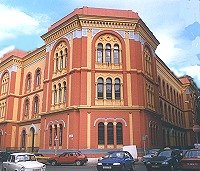Potom pénzért vettek meg egy Banksy-graffitit egy palesztin családtól
London, 2015. április 1., szerda (MTI) – Csalással vettek rá egy palesztin családot arra, hogy potom pénzért eladja Banksy egy graffitijét, amely becslések szerint több százezer dollárt érne.
Rabie Darduna elmondta a BBC-nek, hogy kevesebb mint 175 dollárt adtak neki egy ábrázolásért, amelyet a brit graffitiművész Gázában lévő háza egyetlen megmaradt ajtajára rajzolt.
A múlt évi háborúban több ezer lakóház megsemmisült a térségben. Banksy februárban kereste fel a palesztin területet és a házak romjait „használta” vászonként politikai töltetű graffitijeinek elkészítésére. Festményein például látható egy macska, amint deformálódott fémből formált labdával játszik, vagy gyerekek, akik egy izraeli megfigyelőtornyon hintáznak.
Dardunáék házának ajtaján egy síró görög isten képét hagyta hátra az utcaművész. Darduna elmondta, egy helyi férfi csalással vette rá az eladásra, azt állította magáról, hogy a művésznek dolgozik. „Nagyon elszomorít minket a dolog, ez csalás” – hangoztatta.
A vevő a BBC tudósítójának azt mondta, hogy szerinte törvényesen szerezte meg a képet, amelyért 175 dollárt fizetett.
Banksy alkotásai azonban ennél jóval többet érnek. Augusztusban az angliai Bristol egyik klubjának falára készített graffitije több mint 590 ezer dollárért kelt el.
www.bbc.com./news/world-middle-east-32139657
Gaza family ‘tricked’ into selling Banksy painting for $175
By Yolande Knell
BBC News, Gaza City
3 hours ago
From the section Middle East
Jump media playerMedia player helpOut of media player. Press enter to return or tab to continue.
Media caption
Bansky visited Gaza in February and used the rubble as a canvas for his graffiti
A man from the Gaza Strip has told the BBC he was tricked into selling a work painted by UK graffiti artist Banksy.
The image of the Greek goddess Niobe, weeping for her dead offspring, was painted on a door from the ruins of Rabie Darduna’s house in Gaza City.
It can be seen in a video released by the secretive artist after his surprise visit to the Palestinian territory a month ago and is on his website.
A local buyer gave Mr Darduna just 700 shekels ($175; £118) for the picture.
However, original Banksy artworks have recently sold for hundreds of thousands of dollars.
‘Museum’
The Darduna family property was one of some 18,000 in Gaza that were destroyed during last year’s 50-day war with Israel, displacing 110,000 people, according to the United Nations.
„It was a two-storey building but only the door was left standing,” says Mr Darduna. „Then a young, foreign man came and painted on it.”
The father-of-six says that after the picture began to get media attention he was approached by a group of men.
A mural of a crying figure by British street graffiti artist Banksy in the Gaza Strip, 28 February 2015
Banksy’s representative says the artist believes the picture should be returned
Doorway in Gaza City now missing door painted by Banksy
The doorway where it once stood now stands empty
They convinced him they were acting on behalf of the artist and wanted to buy the door, as it was part of a series of works.
„They said they wanted to put it in a museum in Gaza where everyone could see it,” Mr Darduna explains.
„One man told me: ‘We’re from the group that did it.’ They made me sign a paper. It said I agreed on 700 shekels. They pressured me and I accepted because I need the money.”
Since losing their house, 20 members of the Darduna family have moved into a cramped, rented apartment, sharing just two bedrooms.
When the BBC contacted the buyer of the Niobe picture he insisted the purchase was legal and refused to comment further.
On Wednesday rumours began to circulate that it had been returned to the family, following media coverage. But the buyer later posted on his Facebook page that the door was still in his possession.
„Really we feel depressed and very upset,” Mr Darduna. „This door is rightfully ours. They cheated us. It’s a matter of fraud. And we’re asking for the door to be returned.”
Losing hope
As well as the painting of the goddess, Banksy left murals of a pink-ribboned cat playing with a ball of mangled metal and children swinging from an Israeli watchtower.
On a wall he wrote: „If we wash our hands of the conflict between the powerful and the powerless we side with the powerful – we don’t remain neutral.”
Banksy mural of a cat in Gaza
Banksy also painted a cat playing with a ball of mangled metal on a wall in Gaza
In a two-minute satirical video, suggesting Gaza as a tourist destination, the artist – whose true identity is not known – sought to highlight the plight of its residents.
Many who have been displaced have begun to lose hope.
They have returned to their damaged homes, patching them up or camping outdoors, while they wait for promised financial support and construction materials so they can rebuild.
More than $5bn (£3.4bn) was pledged in international aid. However the authorities in Gaza say little has arrived.
Banksy has previously visited the occupied West Bank at least twice.
Rage, Flower Thrower in Beit Sahur
Rage, Flower Thrower, in Beit Sahur, depicts a protester wearing throwing a bouquet of flowers
Stop And Search, at St Michael’s Hotel in Bethlehem
Stop and Search, painted on a hotel wall in Bethlehem, shows an Israeli soldier being patted down by a girl
His street artworks in Bethlehem – including some on Israel’s separation barrier – are now a tourist attraction.
A Banksy shop sells magnets, T-shirts and other customized souvenirs.
‘Special character’
However here too, his murals have stirred up tensions. Those showing a donkey and a rat were initially thought to be insulting and were painted over.
Others were cut down and sold for much less than their true market value. Art dealers shipped at least two overseas.
„At first nobody knew who Banksy was, not even me and I was involved in his exhibition,” says artist, Ayed Arafah from Bethlehem’s Dheisha refugee camp.
Ayed Arafah
Ayed Arafah says Palestinians have slowly realised the worth of Banksy’s artwork
„Artists could see his work had a special character but other people just thought he was like any other international [figure] who came to make graffiti on the wall and support the Palestinian cause.”
„But then it became clear how many foreigners came to see the work and slowly people realised what it was worth.”
„Now I think that even if [Banksy] drew something very small – even a dot – people might cut down their walls and try to sell it.”
Share this story About sharing














